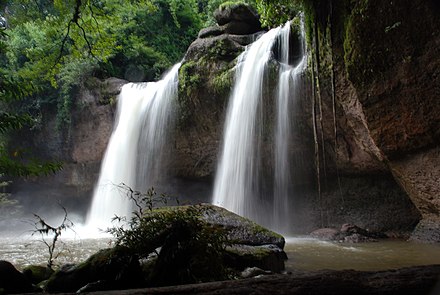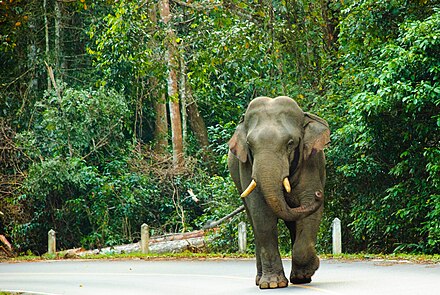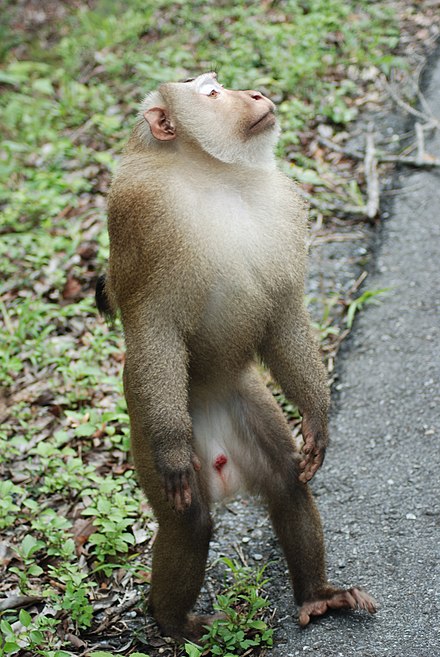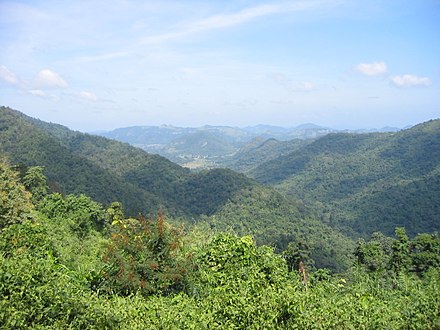Khao Yai National Park - nature reserve in Thailand
Khao Yai National Park is a national park in Southern Isaan, Thailand.
Understand

History
Established in 1962, Khao Yai was Thailand's first national park. Today it is the third largest national park in Thailand and, in 2005, the area along with the surrounding Dong Phaya Yen mountains was listed as a UNESCO World Heritage Site.
Landscape
Flora and fauna
Tropical moist evergreen forest covers the central area of Khao Yai National Park. The rich diversity of plants (about 2,000 species) astound the new-comer. Towering trees draped in mosses, climbers and epiphytes, tangled trunks of the strangling figs, drooping lianas and spiny rattan palms, delicate ferns, multicoloured lichens and an ever-changing array of fungi. There is always something new to discover in the forest. The park has a diverse plant community of five main vegetation types:
Dry evergreen forests: These forests cover the lower slopes of Khao Yai. There are a number of important plant species found within this type of forest, including Dipterocarps and Hopia. Bamboo is also often found in drier forests.
Dry deciduous forests: These forests also cover the lower slopes of Khao Yai. The most important plant species found within deciduous forests include Afzelia, Xylia and Lagerstroemia.
Tropical moist evergreen forest: Tropical Moist Evergreen Forest covers around 70% of the park, including its central area. Dipterocarps are an important species found within these forests.
Hill evergreen forests: This forest type grows above 1,000 m. In hill evergreen forests, the trees are smaller and ferns, mosses and epiphytes abound. Lithocarps and Catanopsis are among the most important species found here.
Grasslands: These areas are a unique habitat, and provide a grazing area year – round for some of the parks animals. Grassland provides a welcome relief to all the forest . The park mange (burn annually) the grassland to prevent trees from invading and to provide year-round grazing for deer, elephants and guar. Wildlife is plentiful (70 mammal species, at least 74 species of herptile and thousands of invertebrates) but often hard to see. Sambar (large, grey-brown, often in groups) and barking deer (smaller, red-brown, usually in pairs or alone) are frequently seen in the grasslands or on spotlighting tours.
Khao Yai's forests are teeming with wildlife and birds. Look up and down and form side, tread softly, and listen carefully to discover the real movers and shakers in the forest. Gibbons provide an excellent morning wake-up call with their mournful hoots. Quiet, patient walkers may catch a glimpse of these tree-living apes. Macaques are often seen on the roadsides. Elephants are sometimes spotted at salt-licks or on the road in the evenings and lucky (?) tourists may spot a tiger in the grasslands during the evenings.
Civets, squirrels, porcupines, and wild pigs add a bit of variety. Snakes and lizards usually make their presence known by a rustle in the undergrowth as you are walking. If you see a snake, treat it as dangerous unless you know otherwise! Geckos are frequently seen catching insects on building walls and ceilings. Cicadas never stop their scratchy hum. Look up and down and from side to side to spot the real movers and shakers in the forest - the insects and invertebrates. A few Siamese crocodiles (Crocodylus siamensis) have been found within the park- some believe the crocodiles were released there while others believe they may indeed be a genuine wild population as this species can be present at higher elevations (such as the Cardamom Mountains of Cambodia.) This species is not aggressive towards humans and rarely grows larger than 3 metres (10 feet.)
Birds: They have lots – over 320 species have been recorded. To the non-expert, birds are often just mysterious whistles, trills and calls, or a flutter of wings and a glimpse of colour. Patience is needed, good binoculars and a bird guide help. Roadsides, the old golf course, grasslands and the watching towers are good places to start . Hornbills are quite easy to spot, and hear the "gak gak gak" laugh of the Indian Pied (often seen in big flocks near Nong Pak Chi Tower in the evenings), or the deep resonant "gok...gok" of the Great Hornbill (usually seen in pairs or alone, the biggest of Khao Yai's hornbills)
Bats: Nearly 1 million insect eating bats live in a cave on the edge of the Park. Drive about 3 km to the north of the Park Chong entrance gate and take a small track on the left-hand side just past a temple. A few hundred metres up here take a right-hand turn and follow the track to the end. You can climb the hill to the cave. Please do not enter the cave - you will disturb the bats. Allow them to come out for about 3 minutes before taking any flash photography.
Climate
The lower regions of the park are around 350 m in elevation. Even at this modest elevation and in general throughout the park, you will find a more attractive climate than in nearby Bangkok. The average daily temperature throughout the year is around 23°C.
Like most areas in Thailand the year is split into three seasons: hot, rainy, and cold.
The hot season lasts from Mar-Apr. Daily temperatures can be a bit above the annual average, but it is still very pleasant due to the higher altitude.
The hot season is followed by the rainy season. This lasts from May–October. Average daily temperatures are still high and humidity increases.
The cold season lasts from Nov-Feb. During this time daily temperatures are pleasantly in the low twenties. Nighttime temperatures might require a sweater as temperatures drop.
Get in
Khao Yai is on the route from Bangkok to Nakhon Ratchasima (Korat). The nearest town is Pak Chong, which can be reached either via most Bangkok-Korat trains or via most buses to Korat. Once in Pak Chong, hire or share a songthaew to the park's main northern entrance.
The south entrance is about 13 km north of Prachinburi. Head north from the roundabout on Rte 3077.
Fees and permits
Thais:
- Adults: 40 baht (2022)
- Children under 14: 20 baht
Foreigners:
- Adults: 400 baht (2022)
- Children under 14: 200 baht
Others:
- Bicycles: 10 baht
- Motorcycles: 30 baht (2022)
- Cars: 50 baht
The entry fee must be paid on each day that you enter the park. If you depart the park and return the same day, the entry fee does not have to be paid again.
Get around
One of the best ways to see the park is renting a car or motorbike in Pak Chong and staying one night in the park. If you don't have your own transport it is quite difficult to get to the park information centre as the bus from Pak Chong usually takes you to the ticket office and the natural park centre is about 10 km away. A lot of people hitchhike and park rangers are usually quite willing to take anyone as long as they contract their services for the day. If you have energy, you can actually walk from the ticket office to anywhere in the park, as the road has an area of grass on each side. Cyclists are common (both road cyclists and touring cyclists), rent a bicycle before the ticket office as there is no rental inside the park.
Most trails are not loops, so even if you have a vehicle you will need to walk or hitchhike back. When you hire a guide, the tour ends at the end of the trail.
There is a single road through the park from the Pak Chong side to the Nakhon Nayok side. The road is sealed and in good condition throughout the 60 km journey, though there are some winding stretches of road. There is a 60 km/h speed limit in the park, and there are numerous speed bumps to remind drivers to slow down. Animals (especially macaques) are likely to be encountered on the road, so caution is advisable at all times. There don't seem to be any petrol stations in the park (March 2022).
There are a number of lookouts along the road where photographs of the scenery can be taken.
See
- Night-time "wildlife spotlighting" is available via pick-up trucks in the early evening. Possible animal sightings include deer, civets, nightjars, porcupines, and occasionally even elephants and other nocturnal creatures.
- Observation towers at Nong Pak Chee or Mo Sing. Early morning is the best time to view the great hornbills, gaur, and sometimes elephants. Gibbons are most active in the early morning.
- About 17:30 a wrinkled lipped bat colony (population estimated at 2 million bats) emerges from a cave 3 km outside the northern gate to begin night time feeding. The bats fly in a ribbon pattern across the sky normally heading into the wind.
- Slide shows at the visitor center are available on weekends and public holidays.
Do

-
There are over 50 km of hiking trails. From easy to hard, one hour to three days. The trails on the map from the visitors center will only have the easier trails. Maps come with English instructions. A guide is recommended for most trails if the tourist has no experience. Trail number 1 is easy, it is paved so it has no mud nor leeches. Having a guide is not strictly required for trail numbers 1, 2 3, 4, 5, 7.
-
Kayaking and rafting services are available in Prachinburi, in the far southeast of the park.
-
Klong Pa Kang-Wang Haew-Dinosaur Footprint. Four-day trek to see a dinosaur footprint.
-
Meeting rooms are available with audiovisual equipment for seminars and workshops.
Waterfalls
Visit some of the spectacular waterfalls. They might not be the largest you have seen but the scenery is simply stunning. During hot season some waterfalls might be almost dry. The rainy season is the best time to see spectacular falls. During the months of Jun-Aug streams have plenty of water. Under these wet conditions flora also will be at its best.
- Heo Narok Waterfall - The Haew Narok waterfall is the largest waterfalls in the park. It is a three-tiered structure that extends 150 m from the top tier to the basal lake. The waterfall is about 10 km from the south gate along the central road through Khao Yai.
- Heo Suwat Waterfalls - This waterfall runs over a 20-m cliff into a large pool below. It is about 8 km to the east of the visitors center and can be visited easily by car along one of the main easterly roads. It can also be reached by an 8 km hike from the visitor center (walk number 4) which takes about 4–7 hours. It is made up mainly of multiple layers of sandstone conglomerates with large interbeds of basalt.
- Heo Sai Waterfalls - Haew Sai Waterfalls are 700 m north of the Haew Suwat Waterfalls. It is 8 km east of the visitor centre and can also be reached via car or hiking.
- Heo Prathun Waterfalls - Smaller waterfall that is about 1 km north of Haew Sai waterfall.
Buy
At Zone 1 in the Visitor Centre there is a small souvenir shop selling souvenirs from Khao Yai National Park: bags, T-shirts, and most important, leech socks to wear while you're hiking in the jungle to prevent these creatures from getting under your clothing. The shop doesn't seem to have set opening hours, so don't assume it will be open when you visit.
You can book guides and night safaris at the Visitor Centre.
Eat
At Zone 1 there are small food stalls and a restaurant where visitors can order a variety of Thai food and drinks. Get there before 18:00.
The restaurant at the Lam Tha Kong camping ground has friendly staff. This one shuts its doors at 17:30 though on Fridays and Saturdays they usually close later.
- Nina's. Nina's is an air-conditioned restaurant with Western coffee and desserts as well as great traditional Thai dishes. Not cheap, but good food. A quick walk from Greenleaf. 200 baht
Drink
Don't assume the stalls and restaurants will be open when you visit: take plenty of water with you.
Sleep
- Camping is permitted in camping zones.
- Lodges and cabins are available for singles and groups. Reservations are required. Some park lodges are only available on weekends.
- Baan Saranya Lodge & Restaurant, 298 Moo 2 Pak Chong, Thanarad Rd, km 13.5, Muu Si (In Muu Si, the last village before the park entrance, along Thanarad Rd, the main road access to the park), +66 44 297597, baansaranya@hotmail.com. Clean bungalows with air-con, hot showers, and TV. A nice setting with good looking bungalows, restaurant and bar, and nice Thai family owners. 800-1,200 baht
- Jungle Cabins/Camping, tours@tontantravel.com. Overnight stays in cabins or tents. The cabins and the camp grounds are in the middle of the park surrounded by jungle. Wild animals sometimes visit these areas, both during the day and at night. The cabins are basic, wooden rooms with separate beds (rather hard mattresses), an attached bath, toilet. warm shower, blankets, pillows & towels (electricity available). The other possibility is camping in a tent; pillows, sleeping bags and mats can be rented. It may be possible to camp under a shelter. Showers and toilets. Unheated water is available (not too cold) and electricity is limited to a small box near the park office at the camp site.
- The Jungle House, 215 Moo 5 Thanarat Rd, km19.5 Muu Si (Left of the main road after the village of Muu Si, with a large sign that's hard to miss), +66 44 297183, the_junglehouse@hotmail.com. Bungalows spread over a wide area of jungle, creating a tranquil atmosphere. Bungalows have air-con, hot water, TV and refrigerator. Activities include elephant riding and rock wall climbing.
- Moon River Resort, Khao Yai Rte 3077 (2.8 km south of the south entrance of Khao Yai, Prachinburi (7 km north of roundabout on Rte 3077)), +66 81 1606332. Bungalows (air-con, fan, TV), pool, restaurant. Relaxing and nice ambiance. Pickup service from Prachinburi. 350-1,700 baht
- Park Bungalows. Accommodations sleeping from 1-24 people are available for rent from the park office.
- Sak Phu Duen Hotel. Restaurant and pool. 3,900 baht
There are also accommodations in the nearby town of Pak Chong.
Stay safe
Do not swim in the rivers and waterfalls, there may be crocodiles.
It is easy to get lost because animal paths often look like trails, and also because fallen trees often hide parts of the trail. There are many signs but they are only visible when going the right way (all trails are one-way). OpenStreetMap has all of the numbered trails.
Go next
Khao Yai National Park
dnp.go.th/parkreserve/asp/style1/default.asp?npid=9&lg=2Nakhon Nayok
Primary administrative division


.JPG/440px-Asian_water_monitor_(Varanus_salvator_salvator).JPG)